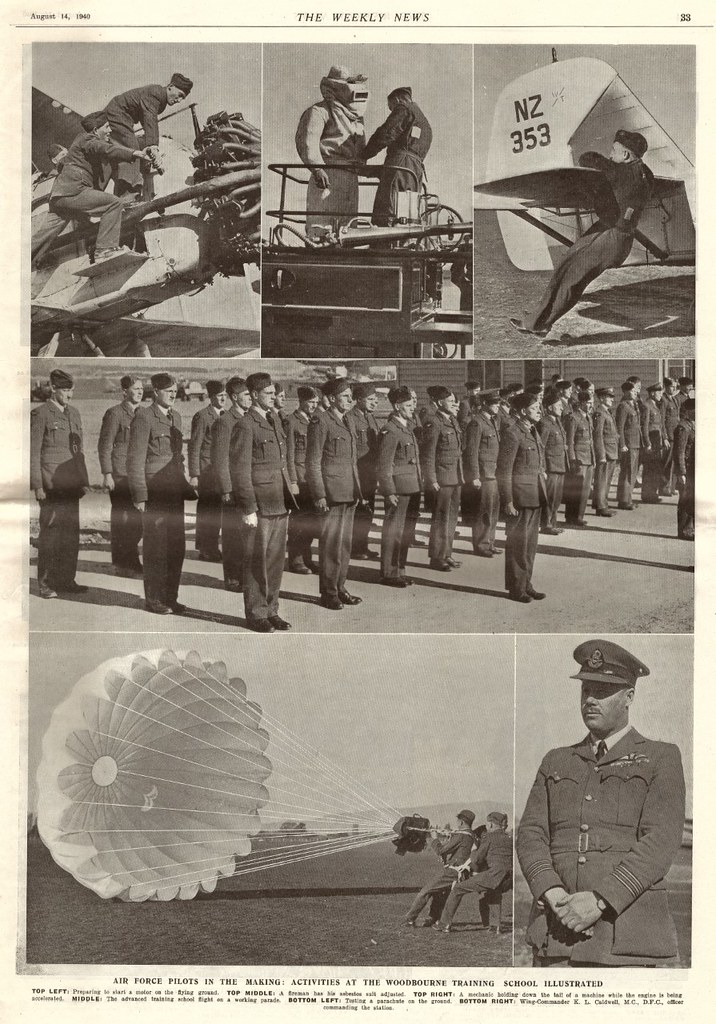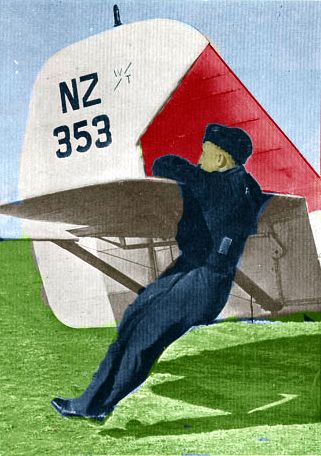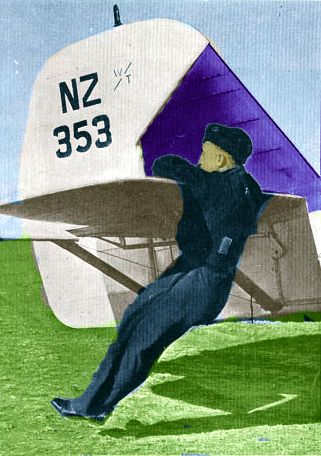|
|
Post by Dave Homewood on Mar 22, 2016 1:36:25 GMT 12
I know we have discussed this topic here before on the forum. I cannot remember the thread and cannot locate it, but I'd posted a photo of a Vickers Vincent at RNZAF Station Woodbourne in the early part of WWII, sitting on the airfield with an Oxford from memory, and the tail post looked in the photo to be a different colour from the rest of the aeroplane, it looked dark as if painted red, blue or maybe black, in contrast to the overall silver scheme of the rest of the aeroplane. Some thought it was just a shadow at the time and that it was also silver but the sun caught it in a way that caused a darkness. I later found another photo that indicated my theory of a colour applied to the tail was likely correct but it was still questionable. I now think there's no question here in this photo of Vincent NZ353, it is wearing a coloured paint. So what do you reckon, is it red or blue?  |
|
|
|
Post by TS on Mar 22, 2016 7:34:25 GMT 12
Could It be as simple as a repair to the Tail post has been carried out and that the colour is red. But it is only the primer coat that we see prior to the finish coat? Or didn't they bother with a primer coat back then?
|
|
|
|
Post by davidd on Mar 22, 2016 9:26:11 GMT 12
No. 2 Flying Training School at Blenheim (later renamed Woodbourne) was, like No. 1 at Wigram, and No. 3 at Ohakea, divided into two squadrons, Intermediate Training Squadron (ITS) and Advanced Training Squadron (ATS). Based on pre-war RAF practise, ITS aircraft were distinguished by blue markings, and ATS by red markings (I think I have that the right way round!) Blenheim/Woodbourne chose to use the fixed tail fin (it is not a post!) as the means of distinguishing one squadron from another, using these colours. Wigram also used these colours on its Grebes, Avro 626s, Oxfords and Vildebeests but they used a broad stripe on the rear fuselage in the squadron colour, although on the 626s and Grebes this was in a different format. Wigram also used large codes (letter/number format) in the same colour, and the Vildebeests additionally had large flashes in the squadron colour on their ample undercarriage spats. Later in the war, Wigram also used a different system, using the engine cowlings as the prime area for displaying the squadron colour, with red cowlings for ATS aircraft, and plain yellow ones for ITS (This was from late 1943 onwards when camouflage was completely abandoned, and overall training yellow became the norm.)
David D
|
|
|
|
Post by shorty on Mar 22, 2016 9:38:23 GMT 12
|
|
|
|
Post by Dave Homewood on Mar 22, 2016 11:23:34 GMT 12
Yes Shorty, your photo 2 and 3 are the ones I was remembering. Thanks. The photo of NZ300 looks plain overall silver to me.
And yes David, I was thinking too that it would be Squadron markings within the school as done at Wigram. The photo I found last night has the best evidence I have seen that the tails were indeed coloured, would you all agree?
Now we need to figure out which aircraft were in which squadron wo so can ascertain which had red tails and which had blue... I guess logbooks and ORB's for 2SFTS will help there.
It is interesting most of these Vincents have had their spats removed, I wonder why. I have seen photos of the spats of Vildes/Vincents also wearing very classy coloured cheat line markings. I am not sure if they were RNZAF applied or left over from RAF service.
|
|
|
|
Post by isc on Mar 22, 2016 19:34:29 GMT 12
Perhaps the spats were removed because of muddy airstrips. Another thought is balancing performance (?speed?) over weight. isc
|
|
|
|
Post by Dave Homewood on Mar 22, 2016 20:07:31 GMT 12
Yes I suspect it is the muddy strip thing, a lot of the grass strips became bogs in winter, particularly Ohakea, Whenuapai and Ardmore as they were all swamps (cheap land).
|
|
|
|
Post by davidd on Mar 23, 2016 12:03:08 GMT 12
Wigram in the early war years also proved to be a bit of a bog, so much so that it became standard practice to send the ATS over to Harewood (much drier) for weeks on end for the conduct of flying exercises. I have seen aerial photos of Harewood with quite a long line of Gordons in residence, and also other evidence that a good proportion of the Oxfords being based at Harewood at about the same time (say July 1940). I think quite a lot or work went into improving drainage at Wigram and Woodbourne in 1941. Woodbourne in the early days was quite notorious too as hinted at by others, and Omaka was frequently used by the Vincents, Oxfords and Harvards from Woodbourne over the darker months. The outlying (satellite) fields of Wigram were also useful throughout the year, and no more so than in winter. The Waimakariri field was usually pretty dry (but plagued by stones), as was Birdlings Flat, and also Norwood. The laying of additional lines of "field tiles" (clay pipes) at the worst airfields, and the later building of a very long taxi strip at Wigram, gradually cured most of these squelchy problems. Nevertheless, a visiting Mosquito (HR339) at Wigram had one its large tyres sink through the surface whilst taxying after landing in 1948, being sufficiently damaged as to be subsequently written off. It was stated to be an old "under-runner" or buried stream that caused this problem (possibly caused by the superior drainage installation!)
Incidentally the photo of Vincent NZ300 is a real rarity - have never seen it before. This was one of the two "home-made" Vincents (the other was NZ361), built up from the numerous wrecks of the original aircraft and were consequently such "bitsers" that it was considered only fair and decent to give them entirely new identities. Note also that we have in this single scene examples of a spatted aircraft (in centre), and two without. The latter pair show the two types of wheel seen on the type - early narrow wheels on furthermost aircraft, and the later "balloon tyres" on smaller cast wheels fitted to NZ300.
The solidly built Wing Commander with crossed hands is K L (Keith) Caldwell, CO of 2 FTS at the time.
David D
|
|
|
|
Post by Dave Homewood on Mar 23, 2016 12:51:14 GMT 12
Yes only a few years back I recall an Air Force Museum staff member telling me the developers at Wigram were very concerned because they'd discovered underground streams there that were causing the place to be very boggy. Obviously it wasn't too much of a concern as they built homes there anyway, and as we all know these developers of high density housing developments would never build on unsuitable land that might come back and bite the home owners down the track when their house starts to sink or the ground starts sending up mud, etc.... It's interesting to hear that Waimakariri was a better airfield than Wigram in the wet, as I had always assumed it was merely a pasture paddock that the RNZAF decided was big enough to use for outfield landings. Was any actual runway preparation done there to make it suitable for aeroplanes? You make a great point about NZ300, it is a rare sight to see. I wonder if there were just no spare spats when it was built? Maybe the other spatless wonder in the photo is NZ361?  When these bitsa aeroplanes were created, was there a rigmarole in creating a new constructor's number and associated paperwork for accountability purposes? And would they have had to get approval from Vickers to allow them to fly? Yes Cambridge's own Grid Caldwell is very recognisable. |
|
|
|
Post by davidd on Mar 23, 2016 15:04:45 GMT 12
I don't think that the RNZAF would bother Vickers for approval in 1941 - what happens in New Zealand stays in New Zealand - remember that all the parts used were genuine Vickers (although others may have been repaired examples, using the correct repair schemes I imagine). And the spats should not be taken too seriously - I doubt that they contributed much if anything to speed, and were a pain when continually being choked up on soft airfields. Mighty stylish though.
The Waimakariri field was on the north bank of the river, and was naturally pretty flat (it was part of the great flood plain that constitutes a greater part of Canterbury after all). I went over this field (on foot) with the official PWD map and most of it was pretty much as it was in 1941, complete with original water courses, etc, also the pine trees were still in position (though older and greyer I would think!) However the mighty Waimak is gradually nibbling away at the bank which is very close to the side of the field. In the official war history of the Aerodrome Services Branch of the PWD, there is a bit of information about the satellite fields, and I think I have seen other bits in the Air Pilot and also the Wigram history about them.
David D
|
|
|
|
Post by Dave Homewood on Mar 23, 2016 15:18:26 GMT 12
There's also some info in the three volume books "Tiger Country".
|
|
|
|
Post by isc on Mar 23, 2016 20:58:31 GMT 12
The Waimak strip, along with a number of other satellite strips around Canterbury would be on a gravel base with plenty of drainage.
I know what it's like to have an aircraft sink in the taxi way, at Rex Aviation's (then)new hangar, we had a visit from a Grumman Mallard from Manapori, it rolled up to the bowsers, stopped and slowly sank to it's keel in the newly laid grass. isc
|
|
|
|
Post by Dave Homewood on Apr 2, 2016 16:34:12 GMT 12
I have added a very basic bit of colour to the photo to illustrate what this aircraft would have looked like in either the red or the blue colours. I wish we knew which colour the Flights/Squadrons used and which aircraft belonged to which Flight/Squadrons.   |
|
|
|
Post by davidd on Apr 3, 2016 9:27:02 GMT 12
Dave,
NZ353 was an ATS aircraft. In fact I seem to have a more-or-less complete list of the squadron allocations, although aircraft were occasionally swapped between squadrons after another aircraft had been written off or some other reason.
ITS: NZ102, 109, 111, 112 (later to ATS), 321 (to ATS), 324 (to ATS), 325, 326 (to ATS by approx. 6/40), 330 (to ATS), 327 - 329, 330 (to ATS), 331, 332 (to ATS), 334, 335, 336 - 338, 342, 345. Also Moth Minors NZ591, 592, presume also Tiger Moth NZ733. However no proof that these Moths were ever in anything other than "normal training colours", no proof of codes or coloured fins.
ATS: NZ 101, 108 (?), 112 (from 6/40), 300 (from 11/40, rebuild), 305, 309, 316,318, 320, 321 (ex ITS), 322, 323, 324 (ex ITS), 330 (ex ITS), 332 (ex ITS), 333, 340, 347, 352, 353, 354, 356, 359, 360.
Squadron allocation for NZ350 not known at this stage, although only saw brief service in approx. July/Aug 1941, then to 3 GR Sqdn.
Total number of Vincents/Vildebeests in service with 2 FTS during 1941 ranged from 29 to 35 up till late June, then dwindled quickly after that with arrival of the new Harvards, down to 26 at beginning of July, to 18 by 1/8/41, 8 by 1/9, 7 by 1/10, 3 by 3/11, and just one by 1/12 (a lonely Vincent). Number of Oxfords in service with this school over same period was between 39 and 43, usually 41 or 42. These strengths reflected the numbers of single-engine and multi-engine pupils passing through in each course, about 30 single engine and 45 multi-engine pupils per course, reflecting the greater demand for the latter for service with the RAF (far more required for Bomber and Coastal Commands, as well as Middle East and Far East service, than for Fighter and Army C-op). Woodbourne Oxfords, incidentally, were also painted with the coloured fins, but by mid-1941 the new squadron identification scheme came in, featuring an oblique stripe around fear fuselage just in front of fin, sloping down and backwards. Often these stripes seemed to have a white outline. This scheme also affected the Harvards, and rapidly replaced the coloured fins.
David D
|
|
|
|
Post by Dave Homewood on Apr 3, 2016 13:52:24 GMT 12
Thanks David, wow it was a massive unit then with upto 35 V-bombers and up to 43 Oxboxes on strength. Woody Valley must have been a very busy place and like heaven on earth to see all those wonderful radials in action.
So we know NZ353 was with the ATS, now, what colour was the ATS tails...?
|
|
|
|
Post by davidd on Apr 4, 2016 13:41:21 GMT 12
Dave,
That would be red - see earlier in thread.
Dave D
|
|
|
|
Post by Dave Homewood on Apr 4, 2016 14:01:39 GMT 12
Thanks.
|
|
|
|
Post by Dave Homewood on Oct 3, 2022 13:49:43 GMT 12
Here is more proof of the coloured tails on the No. 2 SFTS Vickers Vincents, in this crop.  That is cropped from this AFMNZ photo, MUS1101717, Link Here |
|
|
|
Post by Antonio on Oct 3, 2022 15:48:04 GMT 12
Nice catch Dave
|
|
|
|
Post by johnnyfalcon on Oct 3, 2022 20:11:27 GMT 12
Good spotting! And no spats?
|
|



